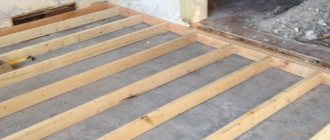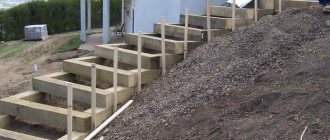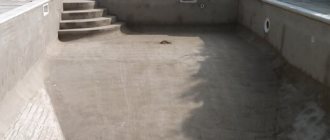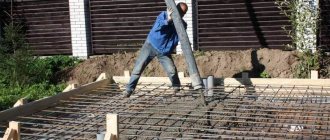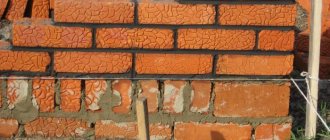Home in the air. We're not talking about a fairytale hut. In a figurative sense, an ordinary house can stand in the air. Gas becomes a component of its foundation, which leads to cracks and subsidence of the foundation.
The reason is insufficient compaction of the concrete mixture at the time of pouring. While the mineral components and water are mixed by the blades of the concrete mixer, they “pull” air into the mixture.
Pores in concrete from air residues during pouring
Without external influences, it can remain in the foundation until it hardens. Loads are not distributed as expected. This is where the problems begin. A concrete vibrator will help you avoid them . What it is and what it is eaten with, we will tell you further.
Types of concrete vibrators, their purpose and use
There are different types of concrete vibrators, which are distinguished by the type of installation:
- Internal or submersible construction vibrators are used to create massive structures. In private construction, they are used when pouring foundations and erecting monolithic walls. They are called so because their tip is immersed in the solution.
- Surface models are used when pouring screeds, floor slabs, large areas of concrete - concreting roads or sites.
- External vibrators are fixed externally to the formwork. This is convenient when creating tall and narrow structures with a dense mesh of reinforcement.
Depending on the type of motor used, concrete vibrators can be electric, pneumatic, or can be powered by an internal combustion engine.
Treatment is carried out immediately after pouring the solution
Electric ones, in turn, can operate from a two-phase 42 V network and from a single-phase 220 V. For private construction, single-phase electric ones are more often used. Moreover, the most common ones are deep ones. This is understandable, because pouring the foundation is one of the most important and complex operations. And deep concrete vibrators are designed specifically for these purposes.
Vibrator design, design options for main components
There are different types of concrete vibrators. According to the method of influencing the poured solution, the tool is divided into two types:
- deep (submersible);
- surface.
Despite the design differences, the equipment has the following common main components:
- drive – the main element of the system, which sets in motion all the other moving parts of the mechanism;
- unbalance – a unit that creates vibration;
- shaft.
Factory products are driven by pneumatic, fuel, electric and hydraulic motors. Suitable for these purposes:
- perforator;
- drill;
- Bulgarian;
- brush cutter.
We suggest you read: How and what to drink correctly in a bathhouse
You can also use the electric motor separately from other tools or equipment. In all cases, it is necessary that the electric motor used has the following technical indicators:
- speed from 3000 rpm;
- Possibility of connecting to a stationary power supply with a voltage of 220 V.
The power of the selected electric motor will affect the efficiency of the work: the higher it is, the more productive the created homemade product will be, and the likelihood of its overload will decrease.
The unbalance (vibration device) is a relatively difficult vibrator unit for practical implementation. For submersible-type models, this is a vibration attachment consisting of a rubber coupling, a sleeve and a metal (steel) impact part.
Internal vibrators are equipped with a flexible shaft that transmits the drive movement to the vibrating tip. A vibrating nozzle is lowered into the thickness of the poured mixture to be compacted and distributes vibrations throughout the solution. A flexible shaft can be made from a stainless steel rod (cable), bearings, or a steel tube.
If you rarely work with concrete, then the easiest way to assemble a vibrator is to use an electric drill or hammer drill as a basis.
Deep vibrators for concrete and their prices
And it's not that simple. There are two types of devices of this type:
- Manual (portable) with built-in electric motor. They have a small mass, the length of the hose and vibrating tip can be from 1 m to 2.5 meters. Prices for this type of equipment are low - the portable vibrator itself without a mace hose costs from 3.2 thousand rubles, plus another 1.5 thousand rubles for the vibrating tip. But there are models that are equipped with a hose right away, and their cost is not much higher: Sturm CV71101 in the basic configuration is equipped with a vibrating hose with a tip with a total length of 1 m, costs 3.5-3.7 thousand rubles.
The manual (portable) concrete vibrator is small in size and weight. They are convenient to work with small volumes
- Portable concrete vibrators with flexible shaft and mace. They are mainly sold separately - a motor unit, to which a flexible shaft and tip of the required size are purchased. The motors themselves cost from 5.7 thousand rubles, hoses are sold at a price of 2.5 thousand rubles per 6 m; vibrating maces from 2 thousand rubles.
Hand-held deep vibrators consist of a durable sealed housing that houses an electric motor of relatively low power - up to 1 kW. This motor is an asynchronous type; unbalances are connected to it, which create oscillations. The working part - the tip or mace - is connected to the body with a rubberized sleeve through which the cable passes. The vibrations created by the motor are transmitted to the handpiece.
The weight of such a device is 6-10 kg. They can work with not very large volumes: they do not have very high power and, accordingly, a small radius of action.
The second type of deep vibrators consists of a motor, a flexible shaft and a working vibrating tip. Unlike the previous version, the motor stands still, and vibrations are transmitted through a flexible shaft. In this case, an important parameter is the length of the shaft, since it limits freedom of movement, as well as the depth of immersion of the club. To compact concrete in the foundations of small structures, a shaft length of 4 m is sufficient, but for larger ones it is better to take 6-10 meters.
Diagram of an internal vibrator for concrete with a flexible shaft
How to choose
Important characteristics of deep concrete vibrators are:
- The diameter of the seal is the area in which vibrations propagate. The larger it is, the faster compaction occurs and the fewer movements are required to achieve results.
- Frequency and amplitude of oscillations. The higher these indicators, the more active and faster the air displacement occurs. But the vibration frequency is also selected depending on the type of concrete: for fine-grained concrete compositions, high-frequency vibrators are used from 10,000 to 20,000 kol/min;
- for medium-grained - medium-frequency - from 3500 to 9000 kol/min;
- for coarse concrete, low-frequency models with oscillation frequencies of up to 3500 kol/min are required.
Since fine-grained concrete is mainly used for pouring foundations, the vibration frequency should be above 10,000 counts/min.
This is what a model with a flexible shaft looks like
In the case of concrete vibrators, price is an indicator of quality. In fact, in the characteristics there is such an indicator as time to failure. It is indicated in hours. This parameter shows how many hours the equipment can operate before the first breakdown. And the higher the price, the greater this resource.
How to use
Improper use of vibration will not only not bring any benefit, but can also cause harm: excessive duration of exposure will cause delamination of the solution, which will negatively affect its strength.
The exposure time depends on the plasticity of the solution and its fluidity. On average, the duration of treatment in one place is 30-60 seconds. As soon as the precipitation stops and cement laitance appears on the surface, the mace must be pulled out.
The step of repositioning the vibrating tip or mace depends on the radius of action (diameter of the compaction). It is 1-1.5 its size.
When compacting foundations or other structures in formwork, you need to ensure that the tip does not touch the walls of the formwork. The minimum distance to the shields should be about 10 cm.
Watch the video to see how to prepare a deep concrete vibrator for use. And one more important nuance: for vibrations to start, you need to lightly hit something with the mace. Then the fluctuations will begin.
Principle of operation
A concrete compactor is a mechanical device consisting of the following main parts:
- power unit (electric motor or internal combustion engine). From this block, mechanical torque is transmitted to the axis of the actuator (flexible shaft);
- mace. A mechanism that generates vibrations. This may be a vibrating tip or needle;
- flexible shaft with eccentric. A device by which rotating movements from a driving mechanism are transmitted to a handpiece or needle. Rotation is transmitted through a flexible steel cable.
The operating principle is quite simple. The oscillatory movements of the eccentric, which is located inside the vibrating tip, are transmitted to the concrete solution. Thus, due to vibrations in the structure of the fresh solution, air inclusions are forced out of it, it is compacted and compacted.
Using a vibrator for concrete comes down to sequentially immersing it deep into the solution poured into the formwork. The immersion step is about 30-50 cm. When working with reinforced concrete, contact of the vibrating tip with metal parts must be avoided.
- When working with the tool, you should strictly follow the manufacturer's recommendations and the safety rules set out in the instructions. Before starting work, a thorough visual inspection and test run must be carried out. The flexible shaft and vibrating tip are consumable parts. If significant wear occurs, they must be replaced immediately.
Surface (area) models
This type is less common, but it can also be used in private housing construction, and in particular for the construction of baths. When constructing small structures, foundations are rarely very deep, often have a medium or shallow depth, so the use of surface concrete vibrators will also compact the solution well. In addition, it can then be used when pouring floor screed.
The selection parameters are the same - amplitude and frequency of oscillation, number of hours before failure, range of action. The vibrator motor itself is installed on the platform and tightened with bolts.
One of the options for a surface concrete vibrator
When working, it is important to tighten the bolts at the attachment points of the working platform. This will ensure better transmission of vibrations and will also prevent the motor from jumping off the mount. This must be done regularly - at least twice in a quarter of an hour.
Before work, the installation must be grounded, then turned on and slowly moved along the plane. To achieve a good effect, the treatment strips should overlap by approximately 10-20 cm.
Popular brands
This review provides the most rated types of construction vibrators for concrete. The choice fell on these models based on an analysis of positive user reviews.
https://www.youtube.com/watch?v=upload
Red beacon EPK-1300.
This is a high-frequency vibrator designed for deep processing of concrete mixture. Transports well. It has a wide base that provides high stability. The Red Lighthouse concrete vibrator is economical. Having little power, it can create a dense, homogeneous structure. It is used on objects with reinforcing structures, as well as in the presence of corner voids.
Sturm CV71101.
The portable Sturm is a hand-held vibrator designed for deep processing of concrete mixture. The country of origin is Germany, and the country of origin is China. Together with the portable concrete vibrator Sturm CV71101, a flexible 4-meter shaft is also supplied. This model has found wide application in the construction of columns and basement walls. The power of the portable concrete vibrator Sturm CV71101 is 2 kW. Weight – 5.15 kg;
Red Lighthouse IVAR-38.
Concrete compactor Ivar-38, designed for deep processing of mortar. All structural elements and the elastic shaft are protected from damage by a steel housing. Concrete vibrator Red Lighthouse provides high density when compacting reinforced surfaces;
Wacker Neuson AR 36/3/230.
The wacker neuson concrete vibrator is designed and manufactured in Germany. The wacker neuson concrete vibrator has good economic performance and durability. Works steadily in difficult conditions.
Wacker Neuson AR 64/3/400.
Surface type model. Country of origin and manufacturer: Germany. It is highly reliable. The wacker neuson concrete vibrator can operate under significant overloads for a long time. It has a compact design, all components are accessible for maintenance. It has proven itself in the construction of walls and reinforced concrete structures.
How to make a vibrator for concrete with your own hands
A construction vibrator can be made on the basis of any power tool with an adjustable speed. Its power should not be too large - no special load is expected on the rotating part. The whole task is to convert the torque of the motor into beating of the tip. This is done using an unbalance placed inside a hollow pipe.
Deep from a hammer drill
The simplest homemade vibrator for compacting concrete can be made from a hammer drill. It should work in impact mode. Actually, an ordinary peak can be immersed in the solution, but after using it as a vibrator, it will most likely need to be replaced. Concrete is an aggressive environment and the metal will begin to rust quickly.
To increase productivity, several transverse rods can be added to the peak. This will increase the coverage radius, but may create difficulties in the presence of reinforcement. It is more effective and safe to weld a washer onto the end of the lance. The impact area also increases, but there are no problems with the reinforcement.
You will see another interesting way to use a hammer drill to compact small volumes of concrete in the video.
From a drill or other similar tool
There are several ways to make a hand-held submersible vibrator with your own hands. One of them is simple and does not require special skills, the second is more complex.
Method one
Buy a ready-made mace with a shaft, but without a drive. They are sold in the same stores where vibrators are sold. To process a layer of mortar of small depth - up to 1 meter - the shaft will cost about 1.5-2 thousand rubles, for a longer one - 2-2.5 thousand rubles. All you have to do is figure out how to connect this hose to the existing drive.
This is an adapter that attaches the factory flexible shaft to the motor housing
Some people attach the tip to a drill, others to a grinder. The main task is to attach the inner tip to the tool axis. The internal shaft of the mace has a hexagon shape. If the tool has the same output, and even the same size, then there is no problem. But if the shape is different, you need to make an adapter.
Then it will be necessary to secure another protective shell. It ends with a metal ring with an internal thread. Here it’s easier not to make an adapter with the same thread, but to drill three or four through holes of small diameter in the ring around the circumference. Screw bolts of suitable diameter into them. Tighten the bolts and secure the shell to the tool. After this, you can check the tool in operation. Don't forget that in order for vibrations to start, the tip must hit something.
Preparation for production
Since ancient times, a method called “bayoneting” has been used to compact concrete; this method is the simplest, but at the same time effective. Punching the concrete mixture with any object, a metal rod, the handle of a shovel, etc., allows you to eliminate air from the solution, which is extremely undesirable in the construction mixture. Naturally, doing this by hand is very difficult.
A homemade device that can be used as a vibrator can greatly facilitate the task and can be made from an ordinary construction hammer. Most construction workers familiar with manual work have just such a tool at home, assembled on the basis of a hammer drill. To create it we will need:
- the hammer drill itself;
- a piece of metal rod, fittings;
- a thick metal plate with a large area;
The power of the hammer drill itself must be at least 1.5 kW. Only then will you be able to work for a long time without overheating. A piece of metal rod or rod (reinforcement) must reach the bottom of the poured cement block, in other words, be equal to the depth of the poured mortar. The first side of the reinforcement is machined so that it can be inserted into the hammer drill chuck and snap into place. The second end of the rod is welded to a metal plate of sufficient thickness and diameter (50 - 70 mm).



